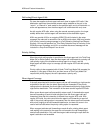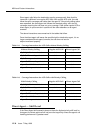
ASAI and Feature Interactions
12-36 Issue 7 May 1998
Electronic Tandem Network (ETN) -
Private Network
Starting with R5: calls that are launched over ETN private network facilities will not
receive charge information even if those calls are eventually routed to a public
network over Advice of Charge (AOC) trunks.
Expansion Port Network (EPN)
The Expansion Interface (EI) board (TN570) makes it possible for the ASAI link to
terminate on an Expansion Port Network (EPN) as well as on the Processor Port
Network (PPN).
It is recommended that any ASAI links critical to a customer’s business terminate
on the PPN to enable the ASAI link to remain operational in the event of a fiber
link or EI failure. Further, resources that are used by a critical ASAI adjunct such
as classifiers, trunks, announcements, and agent ports should also home on the
PPN for the following reasons:
■ To keep these resources in service in the event of a fiber link or EI failure
■ To minimize the amount of cross carrier traffic that could degrade ASAI
response time and system performance
Expert Agent Selection (EAS)
Skill Hunt Groups
Skill hunt groups have the same functions and limitations as vector-controlled
hunt groups (splits). From the ASAI adjunct perspective, both skill hunt groups
and vector-controlled hunt groups are subject to the same ASAI rules and are
treated identically. For example, skill hunt groups, like vector-controlled hunt
groups, cannot be monitored directly (Event Notification Request) by an ASAI
adjunct. The VDN providing access to the vector(s) controlling the hunt group can
be monitored instead if event reports for calls offered to the hunt group are
desired.
Logical Agents
A logical agent’s station extension (for example, physical station from which an
agent logs in) can be domain-controlled (Third Party Domain Control) and all Third
Party Call Control capabilities can be invoked on behalf of the agent’s station
extension. All event reports applicable to ECS stations apply to the logical agent’s


















